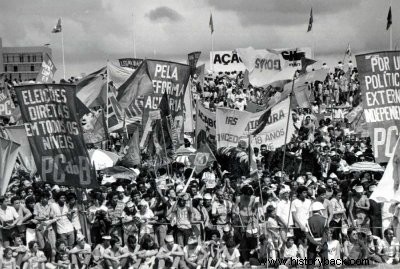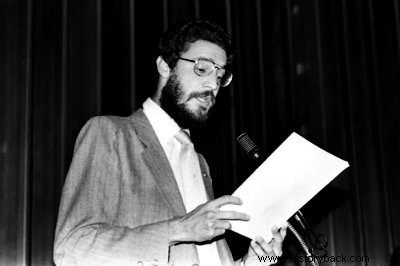"Direct Now " was a popular political movement that aimed at the resumption of direct elections to the post of President of the Republic in Brazil.
The Diretas movement began in May 1983 and lasted until 1984, having mobilized millions of people in rallies and marches.
It had the participation of political parties, representatives of civil society, artists and intellectuals. Despite being marked by significant popular appeal, the process of direct elections only took place in 1989.
That is, 29 years after the election of the last president, on October 3, 1960.
 Rally for direct elections. Praça da Sé, in São Paulo
Rally for direct elections. Praça da Sé, in São Paulo
Abstract
In the period in which the acts for the realization of direct elections broke out, Brazil was governed by the military dictatorship. The military coup that began with the 1964 coup vetoed voter participation in choosing the president and state governors.
During the coup, the National Congress was closed and the choice of the president and governors was left to the responsibility of a military junta.
After the promulgation of the 1967 Constitution, the election of the president began to occur through the vote of the Electoral College.
These were called indirect elections. As of 1979, the military government begins the process of retaking democracy, with the Amnesty Law.
General João Baptista Figueiredo was the last president of the military regime. He determined that the opening of the country would take place slowly and gradually.
It was only in 1982 that direct elections for governor were resumed. In this period of history, Brazil had four political parties in the opposition.
They were the PMDB (Brazilian Democratic Movement Party), PT (Workers Party), PDT (Democratic Labor Party) and PTB (Brazilian Labor Party).
See also:Military coup of 1964Amendment by Dante de Oliveira and the Diretas Já
 Deputy Dante de Oliveira, author of the Diretas Já amendment
Deputy Dante de Oliveira, author of the Diretas Já amendment
In the perspective of direct elections, the deputy from Mato Grosso Dante de Oliveira presented in 1983 a constitutional amendment. The proposal also provided for the end of the Electoral College. If approved, the direct vote would take place in the 1985 elections.
Among the main organizers of the movement was federal deputy Ulisses Guimarães. The parliamentarian promoted, in May 1983, a debate in the Goiânia auditorium. The act was a trigger for rallies that swept the country.
The movement was the translation of the Brazilian people's dissatisfaction with the political persecution and economic inefficiency of the military government.
In 1983, inflation reached 211%, the foreign debt compromised a good part of the country's wealth and the oil crisis kept investors away. In the midst of debates over the succession, General João Figueiredo withdrew from the selection process in January 1984. His departure took place days after a rally promoted by the PT in Olinda and another in Curitiba.
The strategy used for the movement to appear in the mainstream media was the payment of advertising inserts in the intervals of Jornal Nacional, on Rede Globo. Thirty thousand people attended the rally in Curitiba on January 5th.
There were also rallies and marches in Camboriú (SC), on January 14, and Salvador, on January 20. The acts brought together 3,000 and 15,000 people respectively. Popular appeal increased with the participation of 200,000 people in a rally held on January 25, in Praça da Sé, in São Paulo.
The act brought together the main pro-direct political leaders. Present were Leonel Brizola, governor of the State of Rio de Janeiro (PDT-RJ), Ulisses Guimarães and Luiz Inácio Lula da Silva, among others.
Actors and musicians such as Chico Buarque, Milton Nascimento and Fernanda Montenegro were also on stage. From this act, rallies were held throughout Brazil, always with a large volume of participants.
In addition to the streets, participants were also able to follow the congressmen's voting intentions for Dante de Oliveira's amendment.
In February, the "Placar das Diretas" was installed in Praça da Sé. The March to Brasília is also started, a caravan to accompany the vote in the Federal Capital.
The act with the highest concentration of supporters of the directs took place in Rio de Janeiro, on April 10. In six hours, one million people heard supporters of the resumption of direct voting at a rally held in Candelária.
See also:Military Dictatorship in Brazil (1964-1985)Conclusion
Politicians and artists shared the platform in various acts until May 25, when Dante de Oliveira's amendment was voted on.
The session was one of intense movement and tension. Even so, the Chamber of Deputies did not approve the amendment and the elections that year did not count on the participation of the people.
Redemocratization and Direct Now
With the defeat, it was left to the organizers of the movement to negotiate the end of the military regime. From the articulation of governors of the Northeast, the name of Tancredo Neves was nominated to occupy the position of president. The internal dispute took place against the candidate from São Paulo, Paulo Maluf.
The indirect election of Tancredo Neves took place in 1985, marking the end of the military dictatorship that began in 1964. Tancredo did not take over, dying before taking office. In his place, José Sarney governs.
Painted Faces and Out Collor
At the end of the Sarney administration, presidential elections took place in 1989. The election was marked by the victory of Fernando Collor de Mello.
Collor's government is marked by a series of allegations of corruption. Once again, public acts take to the streets in a movement that became known as painted faces.
Collor resigns amid an impeachment process and his deputy, Itamar Franco, takes over.
See also:Redemocratization of Brazil To better understand this subject, visit :
- Institutional Act nº 5 - AI-5
- Economic Miracle
- Amnesty Law
- Democracy in Brazil
- Fernando Henrique Cardoso
- Florestan Fernandes
- History Questions in Enem
- Music from the Military Dictatorship
- Questions about the Military Dictatorship
